Although now a nun, Teresa never got over Grace, the woman who broke her heart years before. When Grace shows up in church, Teresa has a life-changing choice to make.
In the heart-wrenching LGBTQ+ short film “Say Grace,” directed by Phil Hawkins (Star Wars: Origins) and written by Alessia Galatini, we are drawn into the complex emotional journey of Teresa, a former nun who has never been able to fully let go of the woman who broke her heart, Grace. Set in the contrasting timelines of the 1960s and the 1980s, the narrative explores Teresa’s profound transformation from a carefree, spirited youth to a devoted servant of faith.
The story unfolds as the film seamlessly transitions between the present day in the 1980s and nostalgic glimpses of Teresa and Grace’s past in 1968. Teresa’s life has undergone a remarkable shift since the days when her existence was characterized by lightheartedness, freedom, and a deep connection with Grace. Now, as a nun, she lives a composed life dedicated to serving a higher purpose.
However, the sudden appearance of Grace in the church where Teresa has found solace turns her world upside down. Confronted with the person who shattered her heart, Teresa is faced with a life-altering choice. The film delves into the tension between Teresa’s commitment to her religious vows and her enduring love for Grace.
We had the delight to ask Phil and Alessia a few questions about the film itself, make sure to see what they had to say below:
What inspired you to write a story about a nun struggling with her past love?
Alessia: I wanted to tell a story that could bridge that gap between being a person of faith but also being a woman inside the oldest patriarchal institution and, most importantly, a woman in love with a woman. I was intrigued by the contrast between a role that’s traditionally seen as chaste and peaceful and the fact that she’s dealing with so much inner turmoil connected to desire and sexuality.
How did you approach the challenge of depicting both the present day and the past in the film?
Phil: In visualising the film, it was important to me to blur the lines between reality, memory and fantasy. This is an old relationship – a lost love that ended in heartbreak – that haunts Teresa’s dreams. I wanted to capture beautiful imagery that could be a ‘romanticised’ memory of what actually happened. As the story isn’t conventionally linear, I embraced this blurring of time frames in the edit allowing two timelines to wash into each other, sometimes occurring at once for dramatic or emotional effect – Directorially, I made sure that all of the memories and fantasies were shot handheld but gave the present-day scenes a more structured and static look to the photography, still with some off-kilter framing to sent the ordered World off balance.
Alessia: The script is very minimal in its descriptions and the past is told through quick, sensory-driven flashes in the way memories often are. The line between the 80s and the late 60s had to be quite blurred because I wanted people to experience this stream of consciousness the same way Teresa does. As if the way she felt in the past could still be true in the present and vice versa.
What themes do you hope viewers take away from the film?
Alessia: As a queer filmmaker and viewer, I’m tired of seeing LGBTQ+ narratives end in tragedy. It’s a trend even the most well-meaning films find hard to break out of. There’s a power to the way stories are presented, to the options that are offered, and the queer community needs not only more on-screen representation but more on-screen uplifting endings too. So I’d love for audiences to cherish the happy ending here and the idea that love can find its way back into your life when you least expect it. I was also hoping to show that religion and faith are different things, and Teresa’s faith is still important to her by the end and it guides her to what she really wants.
Phil: The uplifting ending is what I loved about the script when I first read it too. I’m a hopeless romantic so I really wanted there to be a happy ending and bring some positivity and love back into the World. And the distinction between love and faith was an important one, as Alessia mentioned.
How did you approach casting for the film and what qualities were you looking for in your actors?
Alessia: I think we were looking for chemistry above all, a pair that could communicate the weight of such a convoluted, decade-long relationship. We casted Maiken (Grace) first and then tested her against our shortlist of actresses for the lead role. With Teresa especially, we needed someone who could deliver a complex performance through facial expression and mannerisms, given the minimal dialogue. It was gravitas for Teresa and charisma for Grace.
Phil: It’s a directorial cliche, but I’m looking for truth. We all really wanted subtle, intimate performances in this film so it needed two superb actors who could carry the emotional subject matter.
Can you talk about any specific shots or scenes in the film that were particularly challenging to shoot?
Alessia: The scenes in the church have quite the backstory. Coverage by an Italian newspaper brought word of the film to the Bishop of the region, who slammed his angry foot down and wanted to terminate the production. His team buried us in bureaucracy. Panic ensued, struggling to get a new location so close to the shoot. Luckily for us, the town came to our rescue: several people called the Bishop, including the local priest, and asked him to reconsider. We only officially got permission two days before we were due to shoot. We were worn out, but victorious.
Phil: Apart from that one Bishop, I was really surprised by how much support we had from the Sasselo community and Mayor. It felt like we had the whole town behind us in making this film. From closing down the town square (and removing cars as we’re shooting for period) to allowing road blocks to shoot the car sequences… it was amazing to be able to do this for a short film. The town square breakup scene, for example, was a hugely important and emotional scene for the actors and I really wanted them to be immersed in the scene by shooting it in one long take. We never would have been able to do that and achieve those performances if we didn’t have complete control over that location. Yes, we could have shot it somewhere different but I really wanted the imposing power of the Church to be the backdrop of the scene and revealed in a rather epic drone shot at the end.
What was the most rewarding aspect of making this film for you?
Alessia: The community that came together to make it happen made it all worth it. We always say it was a labour of love because the budget certainly wouldn’t have covered everything we did. The people from the town supported the project from the get-go by donating to our crowdfunding page and aiding in logistics. We had over sixty people at our wrap party, including the mayor. We became a big multilingual family standing together in support of a new narrative of love.
How do you think audiences will respond to the film, particularly in regard to the portrayal of a nun struggling with sexuality?
Alessia: We’ve definitely seen some tears at our festival screenings. Hopefully audiences can appreciate that, as human beings, we can struggle with conflicting truths about ourselves and still deserve empathy.
What are your favourite short films?
Alessia: Just off the top of my head, to keep with the theme, there’s a comedy short film titled “Yes, God, Yes” by Karen Maine starring Natalia Dyer about a religious girl finding out about masturbation and it cracks me up everytime. I also love French filmmaker Julia Ducurnau, so I have to mention her short “Junior”.
Phil: One of my absolute favorites is “Tune For Two” by Gunnar Järvstad. It’s an oldie but, to me, a perfect short film. I watch it regularly and share it with other filmmakers for inspiration. A simple idea executed perfectly… excusing the pun! Obviously very different to “Say Grace”!




